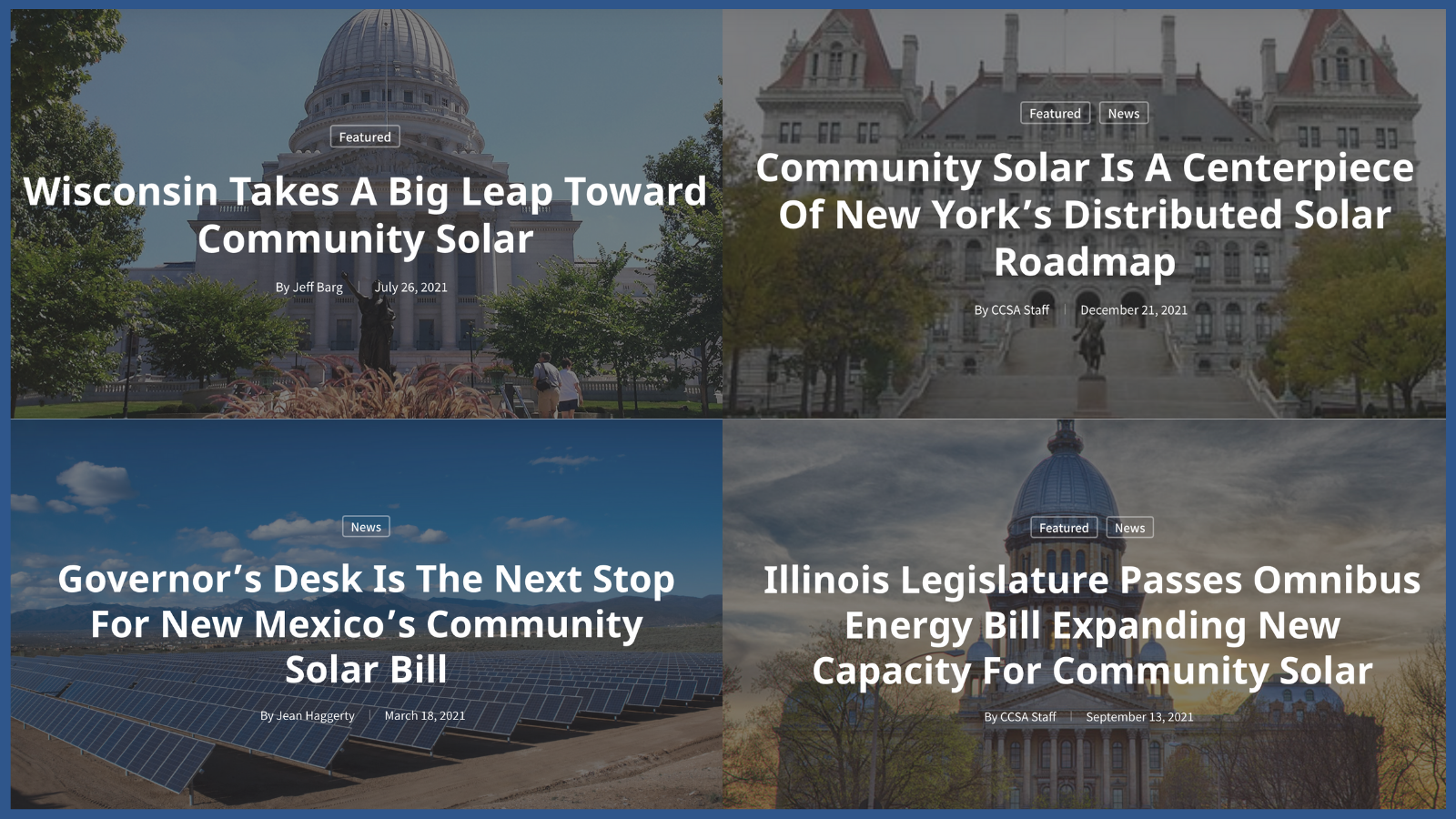December 22, 2021
For community solar, 2021 may well be remembered as the year that, in the words of one advocate, “the dam broke.”
After years of slowly building momentum, 2021 saw bipartisan support for community solar explode, which led to both new markets opening and the expansion of existing markets. State by state, legislatures embraced the potential that community solar holds, and even the federal government has stepped in to expand equity in the clean energy economy.
In this year-end retrospective, we’ll look at the strides community solar made in 2021 and provide a peek at what 2022 might hold.
1. Community Solar Becomes a Bipartisan Issue
Despite reports of partisan division in Washington, D.C., state-level legislatures have found a surprising amount of common ground on the benefits of community solar. Politicians on both sides of the aisle have taken to the ways in which expanding community solar benefits economic development, job creation, consumer access and consumer choice.
“It’s private investment in public infrastructure, number one. Number two, it’s access and choice,” says Jeff Cramer, president and CEO of the Coalition for Community Solar Access. “And number three, you’re seeing this urban-rural partnership.”
“Farming can be an unstable business—particularly as we see increased impacts from climate change,” says Jennifer Spinosi, general counsel and SVP at CleanChoice Energy. “Land leases for solar development provide predictable income and that’s a big reason why we’re seeing interest in states like Ohio, Wisconsin, Michigan and Pennsylvania.”
In Wisconsin, Ohio and Pennsylvania, the lead legislative sponsors of bills to enable new community solar markets are all Republicans, while Michigan’s bipartisan legislation has secured new Republican support this session. It’s part of a growing recognition that the policy aligns well with conservative priorities such as property rights, competition and national security.
“HB 450 is a bipartisan bill, but its two leading sponsors are Rep. Baldridge and Rep. Lanese, both of whom are Republicans,” Spinosi adds. “The Ohio Conservative Energy Forum is also a key partner in the coalition of entities supporting HB 450.”
2021 saw increased numbers of legislators making not just environmental arguments for community solar, but economic ones too.
“It’s not a question of, are you a climate activist or not? And do I believe in solar versus coal, or oil or gas or fracking?” says Manish Nayar, principal at OYA Ventures. “It’s more a question of, are these good jobs that can put people to work?”
2. New Community Solar Markets Open and Existing Markets Expand
This year saw new markets for community solar open in New Mexico, where legislators passed a bill enabling a community solar program for the state, and Delaware, which updated its community solar program to establish a functioning market that allows more people, especially low- and moderate-income customers, to access and participate in the program.
“These new markets represent the opportunity for significant growth and expanded access for customers wanting to go solar,” says Cramer. “There are so many arguments for going community solar, which are anywhere from enabling rural communities to access solar, to enabling competition and economic development, to enabling urban communities and customers that don’t have access, to providing more energy equity and environmental justice.”
As programs proved their popularity, numerous states elected to expand their existing programs both to meet demand and to include customers who have been historically excluded. This year Illinois expanded its community solar program from 213 megawatts to more than 1.5 gigawatts and New York added a dedicated program to increase access for low- and moderate-income customers and announced both a goal and roadmap to power 700,000 additional homes annually, including a plan for how 40 percent of the program’s benefits shall be delivered to disadvantaged communities and low-income residents, with both states scheduled to meet these deployment targets by 2030. Meanwhile, Maryland’s Public Service Commission expanded the state’s community solar capacity to accommodate almost 7,000 additional homes, and New Jersey launched year two of its community solar program, committing to a permanent program and to significant investments in the expansion of community solar and a new dual-use solar program to increase equity and access.
“Expanding the Maryland program and passing the Illinois Clean Energy Jobs Act were huge wins in 2021,” says Spinosi. “Residential rooftop solar has been a cornerstone of energy policy for years, but we know that a majority of Americans do not have access to rooftop solar because they rent, cannot afford the financial investment, or have a roof that simply isn’t well-suited for solar panels. Community solar provides access to the benefits of solar to all residential and small commercial customers.”
The added capacity will allow existing markets the kind of predictability necessary for sustained growth.
“The big win is providing a consistent market for new business, especially businesses in traditionally underserved areas,” adds Sarah Wochos, senior director of policy and business development for Borrego Solar Systems. “Boom and bust doesn’t help anyone, but it impacts new businesses and small businesses disproportionately. So the consistent market opportunity is key.”
3. The Federal Government Signals its Commitment to Community Solar
The federal government is ramping up its commitment to community solar as a key element of its clean energy and climate program. This year the Department of Energy announced its goal of enabling enough community solar development to power 5 million homes by 2025. It’s an ambitious goal that will only be achieved if more states enact policies, but it was a significant signal by the administration about their commitment to community solar.
“States often set the individual market goals and policies, but the federal government is also an important player,” says Wochos. “Some examples are tax credits or other financial policies, FERC rulings about our ability to participate in markets, and guidance to states about best practices.”
Advocates are working for the passage of the Build Back Better Act to benefit community solar, and while this legislation has recently hit a roadblock in the Senate, they hope 2022 will provide new opportunities for the federal government to provide additional support.
“Having long-term certainty on tax credits is the most important, which gives a long-term runway and clear signals to states on how to build their programs,” says CCSA’s Cramer. “Legislation that’s being considered that would cut unnecessary red tape in states to allow public utility commissions to consider the creation of community solar programs in the state.
4. Community Solar Helps to Expand Equity in the Clean Energy Economy
As new markets come online and existing markets grow their community solar programs, multiple states have included carve-out programs and adders meant to expand access for low-income customers, improving environmental health and bringing new employment and economic development opportunities for those who have traditionally been left behind in the clean energy economy.
“When you think about the total addressable market for on-site residential solar, it is actually not that large relative to how many residential consumers of power there are,” says OYA Ventures’ Nayar. That’s why, in states like New York, it has been beneficial to allow apartment buildings with one master meter, or landlords who share utility costs with all of their tenants, to participate. “I think that alone was huge because it allows a lot of affordable housing organizations to participate and get the benefit and then pass it on to their tenants.” New York also recently added a dedicated program to increase access for low- and moderate-income customers.
Increased equity combined with across-the-board growth has been made possible as development costs have shrunk in recent years—a trend that continued in 2021, and will likely stimulate further expansion in 2022. Seizing this moment, a coalition of advocates from civil rights, indigenous, rural, environmental, equity, and solar organizations have developed a roadmap to advance the policies needed for the U.S. to build a stronger grid while expanding equity in the clean energy economy for all.
“Costs have started to come down on projects pretty substantially,” adds Nayar. “In the last six years, we’ve probably seen costs come down 20% to 30%. That’s put more states in play.”
Adds Wochos: “I think environmental and energy equity will continue to be front and center in many clean energy conversations in 2022 and beyond.”
5. Hundreds of Millions of Dollars Flow into Community Solar Industry
Finally, there has been significant interest from the investor community in deploying capital into community solar: leading community solar developers Pivot Energy and Dimension Renewable Energy were both recently acquired to launch them into their next phase of growth, and technology company Arcadia has raised $180 million to expand its role in distributed energy.
And just as 2021 closed, Community Energy Inc. was acquired by Fortune 500 international solar developer AES Corp to meet the growing demand for solar energy, including community solar projects.
“Opening the markets is one thing, but getting the investment community comfortable with the concept is a really big piece of the puzzle,” says Nayar. “I think that we have finally moved that needle to a point where there is general consensus in the investment community.”




